JAPANESE KITCHEN KNIVES
The Best Nakiri Knife: A Japanese Chef’s Guide
21.08.2015
A nakiri knife, also known as a nakiri bocho, is a Japanese-style knife used for chopping vegetables. Characterized by its straight blade edge and squared off tips, the nakiri knife allows you to cut all the way through to the cutting board without having to use a horizontal push or pull. Thin and light in weight, the Nakiri knife is ideal for prepping all types of vegetables.
OUR COMPARISON CHART: THE TOP NAKIRI KNIVES
[table id=7 /]
THE BENEFITS OF USING NAKIRI KNIVES
With so many different types of knives out there, why would you choose a nakiri? What advantages does this type of knife offer?
- Thin, Even Slices: Thanks to its flat blade, the nakiri is able to make paper thin, even slices. If you’re creating a dish with thin ribbons of vegetables, this is the knife you want to have on hand.
- Fluid Chopping: Unlike other knife types, there is no need to “rock” the blade. The edge is straight, and goes right through to the cutting board. A simple chopping motion is all that’s needed to chop just about any vegetable.
- Clean Cuts: Because the flat edge of the blade goes right through to the cutting board, you’re left with clean, even cuts. Have you ever chopped celery or green onions and found that the pieces stick together by tiny little threads? The nakiri eliminates these little threads, so each cut is full and clean.
- Generous Blade Length: A standard nakiri knife has a 5-7” blade, which is long enough to tackle most vegetables.
- Great for Delicate Vegetables: A nakiri knife makes quick work of delicate vegetables without squishing or damaging the vegetable.
The nakiri bocho can be found in household kitchens all over Japan, and it makes for an excellent everyday vegetable knife.
WHAT TO LOOK FOR IN A NAKIRI KNIFE
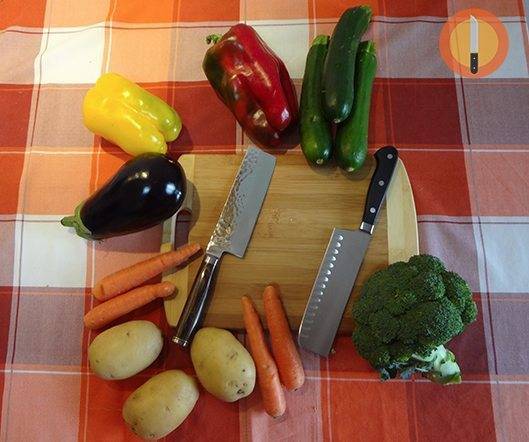
Buying a knife may seem like a simple task, but there are quite a few things you need to consider. These include:
BLADE MATERIAL
The first and most important thing to consider is the blade material. Most modern knives are made of stainless steel, but not all stainless steel is created equal. There are two types you’ll see when shopping for any Japanese knife: low carbon and high carbon. All stainless steel has a varying amount of carbon, and how much the blade contains will determine its quality.
- Low Carbon: A blade with low carbon content will dull much quicker than a blade with high carbon content. Low carbon blades are softer, and need to be sharpened more often.
- High Carbon: High carbon stainless steel will hold its edge for a very long time, and is easy to sharpen. These knives require less maintenance, and boast a longer lifespan.
If quality and longevity are your primary concerns, look for a nakiri knife with a high carbon stainless steel blade.
PRICE
Price is a natural consideration for anyone, but price is also an indication of the knife’s quality. Blades made with high carbon stainless steel typically come with a higher price tag. If you’re looking to invest in a high quality, long-lasting knife, expect to spend $100 to $200 or more.
HANDLE
Along with the blade quality, you also want to consider the quality of the handle. A good knife needs to not only perform well, but it also needs to be comfortable to use.
Look for knives with ergonomic handles that contour to the curves of your hand. Make sure the handle allows for a firm, comfortable grip. A slippery grip can lead to injuries.
BLADE FINISH
Vegetables have a tendency to stick to the blade while you’re chopping. The right blade finish can prevent this from happening.
Many nakiri knives have a hammered finish, also known as “tsuchime” in Japanese. Hand-hammered finishes are designed to reduce drag while you’re cutting, so food is less likely to stick. A blade with a Granton edge can also achieve the same thing. This type of finish creates air pockets while chopping, so food easily releases from the blade.
These are the most important things to consider when buying a nakiri knife. Blade length may also be important to you, with most knives boasting a blade that’s at least 5” long, you should have no issues cutting any vegetable.
NAKIRI VS SANTOKU KNIVES
When shopping for Japanese knives, you’ll often hear people talk about santoku knives. Like the nakiri, the santoku is an everyday knife found in most kitchens throughout Japan. The santoku is a general-purpose knife, and its name translates to “three uses”. These three uses are: mincing, slicing and dicing.
Santoku and nakiri knives are different in almost every way. Both are light in weight, but they have different shaped blades.
The santoku’s blade is slightly curved, which allows for a rocking motion when you cut. The nakiri requires a chopping motion, and produces clean, even cuts. The santoku can also be used for cutting cooked meats, although it’s primarily use is for prepping vegetables.
Both knives have their uses, but the santoku offers slightly more versatility because of its curved blade and pointed edge. The nakiri’s blade is completely flat, which makes it ideal for creating paper-thin slices.
I like to use a nakiri knife when I’m julienning peppers or onions. It’s also great for scoring, so if you cook with eggplant, you might use a nakiri to prep the vegetable for salting. I keep a santoku knife on hand for when I want to make “fancy” cuts or to cut already-cooked meats.
THE BEST NAKIRI KNIVES TO BUY
Looking for a good nakiri knife? There are plenty to choose from, but these two knives are my favorite.
Wusthof Classic Nakiri Vegetable Knife with Hollow Edge Review
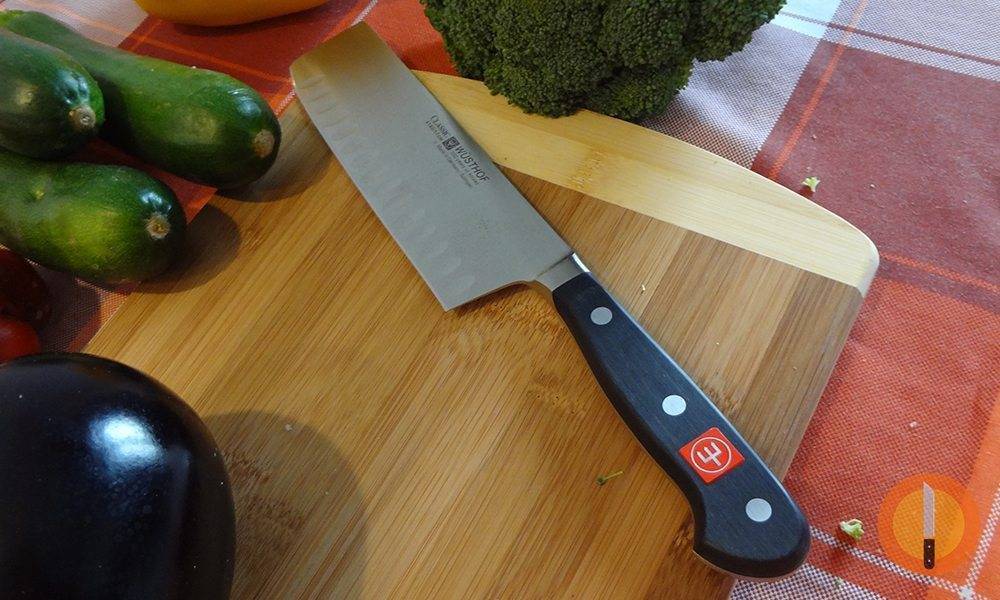
Wusthof is, arguably, one of the most famous names in the knife industry. German-made, this classic nakiri knife is angled on both sides and features a granton-edge blade.
Made with high carbon stainless steel, this knife is 30% sharper than other blades and will hold its edge for 30% longer than regular Japanese-style blades.
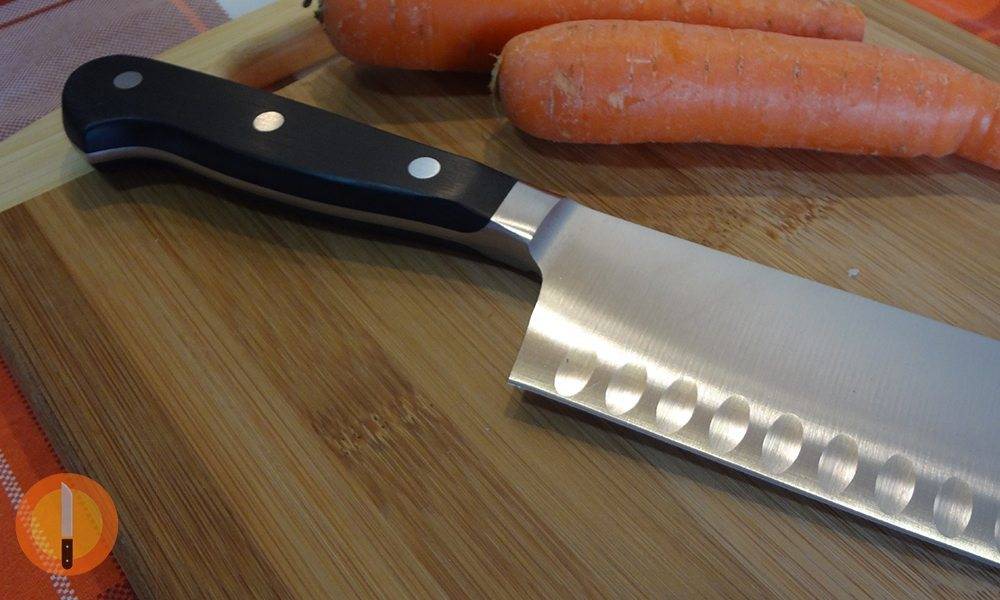
The blade’s granton edge creates little air pockets as you chop, so food never sticks to the blade. It’s full tang, too, so the knife feels well-balanced and is easy to maneuver. The blade itself is 7” long, and the length of the entire knife is 10”. With a weight of about 0.56 pounds, this knife has some weight to it and feels good in your hands.
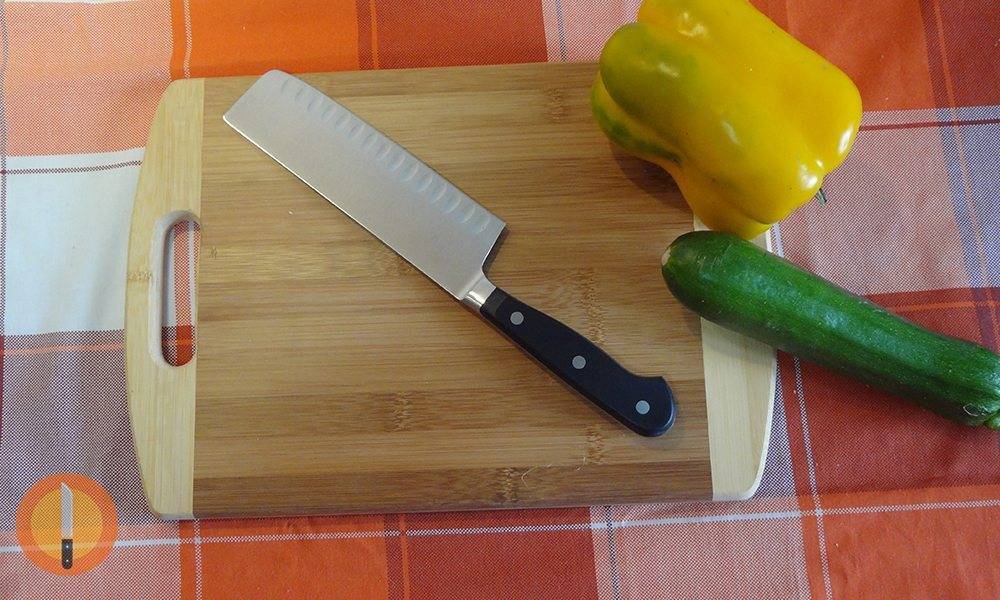
The Wusthof Class Nakiri is one of my favorite knives, and I always have it on hand when prepping vegetables. It makes quick work of just about any vegetable, and I can easily achieve those thin, even slices that I want.
Sure, this knife costs a little more, but for the quality and longevity of the blade, it is well worth the cost.
[easyazon_link identifier=”B002NXNFZO” locale=”US” tag=”knifepla-20″]> Buy The Wusthof Nakiri on Amazon <[/easyazon_link]
Shun TDM0742 Premier Nakiri Knife Review
Shun is another famous brand, particularly in the Asian knife industry. Priced just a little higher than the Wusthof, in my opinion this is a great knife for veggies.
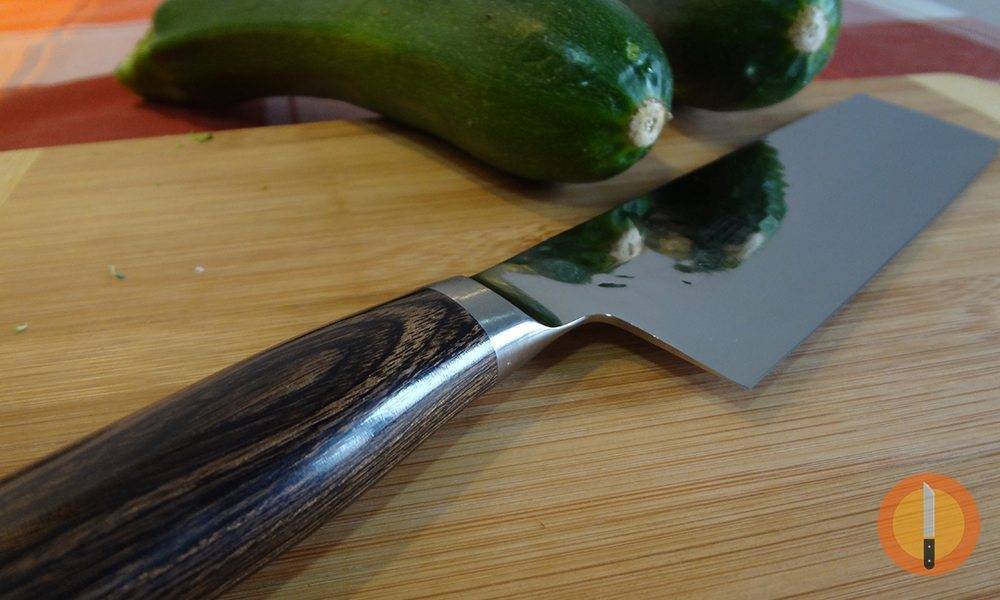
The Premier Nakiri Knife’s blade is a bit shorter than the Wusthof at 5.5”. Constructed with layered Damascus steel, this is a top quality blade with a hammered finish. Also known as tsuchime, this finish reduces drag, so foods don’t stick to the blade while you’re cutting.
The knife’s handle is made of pakkawood, and features an ergonomic design that nestles the curve of your palm. I love that this knife never slips, and it feels like it was made just for my hand. It’s lightweight, and incredibly sharp.

If you have the budget and you want to invest in one of the top nakiri knives you can buy, the Shun Premier Nakiri Knife is the right choice.
[easyazon_link identifier=”B004M42HJW” locale=”US” tag=”knifepla-20″]> Buy The Shun Nakiri on Amazon <[/easyazon_link]
CONCLUSION: IT’S DECISION TIME
Finding the right nakiri blade doesn’t have to be difficult. Either one of these knives will provide you with years of use, and are incredibly easy to sharpen. Once you experience the ease and precision of these knives first-hand, you won’t regret.










